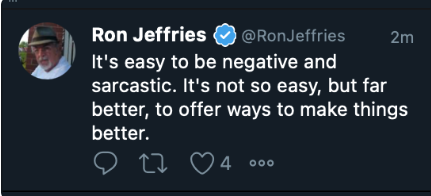Each Sunday morning, I LOVE to read the business section of the local paper. And by "business section" my wife knows that this means the Sunday Comics.
Now I read almost all of the comic strips, but one that keeps popping back up in my memory, is The Family Circus by Bil and Jeff Keane. It's a great strip of a family and all their antics. A recurring panel is the son Billy, and his inability to go directly to anyplace, and rather seems to take a route that might include a slide, petting a dog, climbing a tree and more. This particular comic is the one that really struck home:
I'm reminded of this cartoon often when people ask me about my career path. I am pretty sure that Billy is me.
In looking back at all the roles I've had, the list is very large. In my lifetime, I have probably had 35 jobs, and some of those jobs I had gone through 5-7 different roles within those jobs) I've been working for 43 years, and some of my jobs I've had 30+ years, another 9, and another 15. Rarely did I do just one thing. Matter of fact, my entire work life except for the last 5 years, I've had 2-3 ventures going at the same time. Needless to say, my path has not been a straight one.
I was recently asked about career advice, because this person wanted to become an agile coach. They wanted to know which courses to take in order to reach that goal. My advice for this person, and for most any role, would look more like Billy's path.
Take roles that you've never done before
Most people follow a straight path and only take roles where they have expertise and experience. They stay in the exact same field/industry and climb a corporate ladder, rung by rung. What can result is a person that is engrained within one company/one mindset.
For the employer, this is great because they reduce employee turnover, but for the employee it likely will leave them in a position where they can never leave. Once a person has been within a narrow career field/company for a decade or more, changing careers is incredibly risky and difficult. A varied background, from different industries and roles, can give you perspective beyond your years. It helps you become a potential valuable player in most any work environment. Being in one organization for decades can reinforce a mindset and language from within that organization that may not translate to other organizations. Also, the next thing you take may not be a job at all.
Recently I've left a role to take time away, which is something I have never done before. To hike, breathe, rest, read, and reflect. These past months may likely be some of the most formative moments in my career.
Take roles that challenge you
Almost every role I have ever taken, I had no real previous experience in doing that role. And if you were to have looked at my past experience, it might not have crystal clear as to how or why this next role made sense. And that is what made it fun, and interesting, and challenging.
The easy path, is for someone to take their next role as something fairly easy and comfortable for you, something almost exactly like you've done before but just at a different company. This can offer you some diversification because each organization works in slightly different ways. But I'd encourage you to take something that challenges you, and makes you a bit nervous.
New roles should stretch you a bit, but not too much. Don't take roles where you are clearly not capable. ( I'm not going to be taking any brain surgeon roles anytime soon.) One thing that comes to my memory for each new role I've taken is "I haven't ever done this before, but I know I can figure it out!"
Take roles based on your passion, not income
Nothing is worse than working for an organization where you don't feel like you are aligned with their mission and purpose. Sadly, I've seen many people take roles where they know they aren't aligned due to more income.
Taking a role in a new organization only because it pays a lot more money never seems to work out well. You will end up doing your time there, but will feel empty and unfulfilled. Some of the best career moves I've made were ones where I purposely chose to make less money to pursue passion. We are creatures of passion, and do our best work when we are engaged in something that excited us.
I heard a quote before, and I'm not sure where it originated, but it went something like this: " The best alarm clock is work you are passionate about." Work you are excited for and passionate about wakes up up each day, with ideas and optimism for a bold future. When you find yourself dreading the work day on a consistent basis, it's likely a sign of a lack of passion. And maybe, a time to make a change.
Wrapping up.
Your journey is YOUR journey. It's a series of choices that you make that can shape your career. Never abdicate your journey to an employer and expect them to create a path that fits you. The world is a world of abundance. According to
Statista, there are over 11 million job openings available in the US alone, so what are you waiting for?
Good luck on creating a far more interesting journey.











